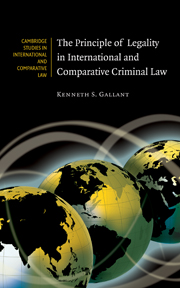Book contents
- Frontmatter
- Contents
- Explanatory Note on Spelling
- Acknowledgments
- Introduction
- 1 Legality in Criminal Law, Its Purposes, and Its Competitors
- 2 A Partial History to World War II
- 3 Nuremberg, Tokyo, and Other Postwar Cases
- 4 Modern Development of International Human Rights Law: Practice Involving Multilateral Treaties and the Universal Declaration of Human Rights
- 5 Modern Comparative Law Development: National Provisions Concerning Legality
- 6 Legality in the Modern International and Internationalized Criminal Courts and in the UN Trust Territories
- 7 Legality in Customary International Law Today
- Conclusion: The Endurance of Legality in National and International Criminal Law
- Appendix A Chart of Non-retroactivity Provisions in Criminal Law by Nations
- Appendix B Legality and Non-retroactivity Provisions as of 1946–47
- Appendix C Constitutional and Other National Provisions Implementing the Principle of Legality Today
- Bibliography
- Table of Authorities
- Index
- Afterword and Update
- CAMBRIDGE STUDIES IN INTERNATIONAL AND COMPARATIVE LAW
- References
3 - Nuremberg, Tokyo, and Other Postwar Cases
Published online by Cambridge University Press: 04 July 2009
- Frontmatter
- Contents
- Explanatory Note on Spelling
- Acknowledgments
- Introduction
- 1 Legality in Criminal Law, Its Purposes, and Its Competitors
- 2 A Partial History to World War II
- 3 Nuremberg, Tokyo, and Other Postwar Cases
- 4 Modern Development of International Human Rights Law: Practice Involving Multilateral Treaties and the Universal Declaration of Human Rights
- 5 Modern Comparative Law Development: National Provisions Concerning Legality
- 6 Legality in the Modern International and Internationalized Criminal Courts and in the UN Trust Territories
- 7 Legality in Customary International Law Today
- Conclusion: The Endurance of Legality in National and International Criminal Law
- Appendix A Chart of Non-retroactivity Provisions in Criminal Law by Nations
- Appendix B Legality and Non-retroactivity Provisions as of 1946–47
- Appendix C Constitutional and Other National Provisions Implementing the Principle of Legality Today
- Bibliography
- Table of Authorities
- Index
- Afterword and Update
- CAMBRIDGE STUDIES IN INTERNATIONAL AND COMPARATIVE LAW
- References
Summary
The Nuremberg Judgment correctly stated then-current law: nullum crimen sine lege was not a limitation of sovereignty. Specifically, nullum crimen sine lege did not state an international law-based human right that could be asserted by an individual against a state, group of states, or international organization. It was correct at least partly because, at the time, there was little interference by international law in the internal arrangements by which governments ruled their people, and the Nuremberg Judgment itself did not announce the violation of the principle of legality as one of the crimes against humanity and war crimes of which the accused might be convicted. Substantive international human rights and humanitarian law had not evolved to make this a right of individuals enforceable against states (or other prosecuting authorities, such as international organizations – should they come to exist).
The English version of the Nuremberg Judgment was also correct in stating that nullum crimen sine lege is a principle of justice. At least it was recognized as a fundamental principle of criminal justice by many persons and nations by the time of World War II, including the principal French judge Henri Donnedieu de Vabres.
The drafters of what became the Charter of the International Military Tribunal (IMT), which known as the Nuremberg Charter, struggled over the issue of legality and ex post facto legislation, and whether the issue could be defined out of existence simply by including criminal definitions in the text of the Charter.
- Type
- Chapter
- Information
- Publisher: Cambridge University PressPrint publication year: 2008



